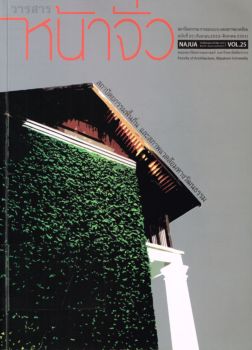สัญญาณแห่งการฟื้นคืนชีวิตของภูมิทัศน์วัฒนธรรมของหมู่บ้านในภูเขาของญี่ปุ่น
Keywords:
ภูมิทัศน์วัฒนธรรม, ที่สูง, หมู่บ้าน, ญี่ปุ่น, cultural landscape, upland, Village, JapaneseAbstract
การศึกษานี้แสดงให้เห็นวัฒนธรรมของหมู่บ้านในพื้นที่ภูเขาของประเทศญี่ปุ่นที่มีวิถีชีวิต และระเบียบปฏิบัติในการอยู่อาศัยร่วมกับสภาพแวดล้อม จนเกิดเป็นภูมิทัศน์วัฒนธรรมที่เรียกว่า “ภูมิทัศน์ซะโตะยะมะ” กรณีศึกษาหมู่บ้านมุคุกะวะ ซึ่งเป็นพื้นที่ต้นนํ้าของทะเลสาบบิวะโคะ (Biwako Lake) ชี้ให้เห็นถึงปรากฏการณ์ “หมู่บ้านถูกทิ้งร้าง” ในประเทศญี่ปุ่น จากการละทิ้งถิ่นฐานและละเลยพื้นที่เกษตรกรรมตั้งแต่ช่วงหลังสงครามโลกครั้งที่สองจนถึงปัจจุบันส่งผลให้ภูมิปัญญาในจัดการทรัพยากรธรรมชาติอย่างสมดุลสูญหายไป จนทำให้ภูมิทัศน์วัฒนธรรมของหมู่บ้านค่อยๆ สูญหายไปด้วย อย่างไรก็ตาม ท่ามกลางสถานการณ์ที่เป็นอยู่ หมู่บ้านมุคุกะวะแสดงให้เห็นถึงสัญญาณของการฟื้นชีวิตของภูมิทัศน์วัฒนธรรม โดยสัญญาณที่ปรากฏเด่นชัดคือ การสร้างสรรค์ระบบการช่วยเหลือเกื้อกูลกันในชุมชนและการแลกเปลี่ยนแรงงานในหมู่บ้านแบบดั้งเดิมที่เรียกว่า ระบบยุอิ ขึ้นมาใหม่ซึ่งช่วยสร้างเสริมกระบวนการผลิตฟื้นฟูวิถีชีวิต สร้างความสัมพันธ์ระหว่างสมาชิกในชุมชน ตลอดจนรักษาอัตลักษณ์ของหมู่บ้าน
หัวใจของระบบใหมที่สามารถเป็นแนวทางให้กับพื้นที่หมู่บ้านในชนบทแห่งอื่น คือการสืบทอดภูมิปัญญาท้องถิ่นสู่คนรุ่นใหม่ แต่ปรับเปลี่ยนแนวคิดและระเบียบปฏิบัติให้เหมาะสมกับสถานการณ์ในปัจจุบัน มีการเปิดชุมชนที่เคยมีการรวมกลุ่มอย่างเหนียวแน่น ให้เปิดรับคนเข้ามาอยู่ใหม่ซึ่งเป็นผู้ที่นำแนวคิดใหม่เข้ามา และช่วยเหลือด้านแรงงานในชุมชนที่กำลังอยู่ในภาวะขาดแคลน รวมถึงการเปิดรับการสนับสนุนจากหน่วยงานภายนอกมากขึ้น จากการดำเนินงานที่ผ่านมา สิ่งที่ชาวบ้าน องค์กรชุมชนและภาครัฐควรดำเนินการต่อไป คือการสร้างโครงข่ายระหว่างหมู่บ้านและหมู่บ้านกับเมือง เพื่อรักษาระเบียบปฏิบัติของหมู่บ้านที่ยังคงเหลืออยู่ นอกจากนี้ โครงการภาครัฐในปัจจุบัน ทั้งการขึ้นทะเบียนภูมิทัศน์วัฒนธรรมพื้นที่ที่มีคุณค่าสูงสุด และโครงการอนุรักษ์พื้นที่ภูมิทัศน์ซะโตะยะมะในพื้นที่หมู่บ้านบนภูเขาของญี่ปุ่นที่มีอยู่โดยทั่วไปควรได้รับการดำเนินการอย่างต่อเนื่องต่อไป
The Signs of the Re-birth of Japanese Upland Village Cultural Landscape
Wimonrart Issarathumnoon, Ph.D.
Faculty of Architecture, Chulalongkorn University
The study illustrates culture of Japanese upland villages expressing ways of life and human interaction with surrounding environment, which shapes cultural landscape, called “Satoyama Landscape.” The case study, Mukugawa Village, one of watershed villages of Biwako Lake, identifi es the situation of ‘Abandoned Village’ in Japan. Since the post Second World War up till now, the situation of depopulation and a number of neglect farmlands in upland villages has caused the loss of local knowledge in accessing and utilising natural resources in a balance way. Cultural landscape of such villages thus has been gradually disappeared. However, in the hazardous situation, Mukugawa Village shows the re-birth signs of cultural landscape. The notable sign is the re-creation of the traditional mutual help and labour exchange, known as the new Yui System. The new system helps for restoring a process of agricultural production, enhancing local ways of life, building good
relations among villagers, and preserving village identity.
The essence of the new system, which can be a good way for other rural villages, is to transfer local knowledge from aging farmers to young people, and to adapt traditional practices to fi t with recent circumstances. Moreover, the other key
notion is to open the close-knitted village to welcome new comers who convey new ideas and serve for underprovided labour works, as well as to accept the supports from outside organisations. Regarding to foregoing practices, the villagers, community organisations, and government authorities should build networks of villages as well as the connection between villages and cities, to maintain persisting village practices. Furthermore, the current governmental projects and plans—both
the nomination of Important Cultural Landscape, and the Satoyama Initiative Project, which preserves and raises awareness of Satoyama Landscape in Japanese common upland villages—should be practiced over a long-term period.





